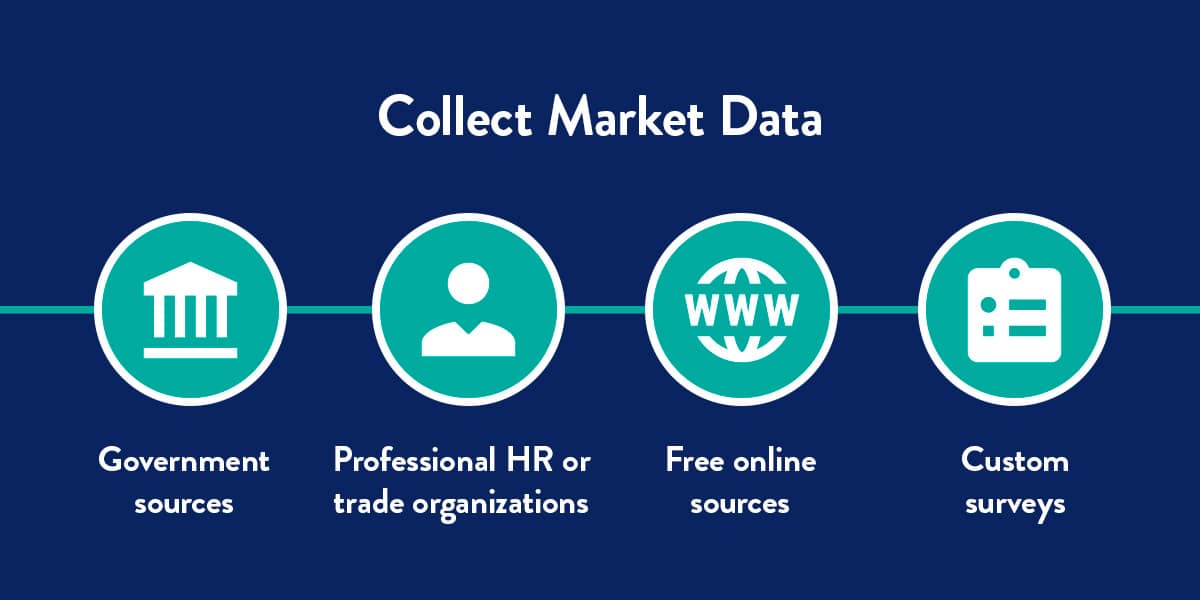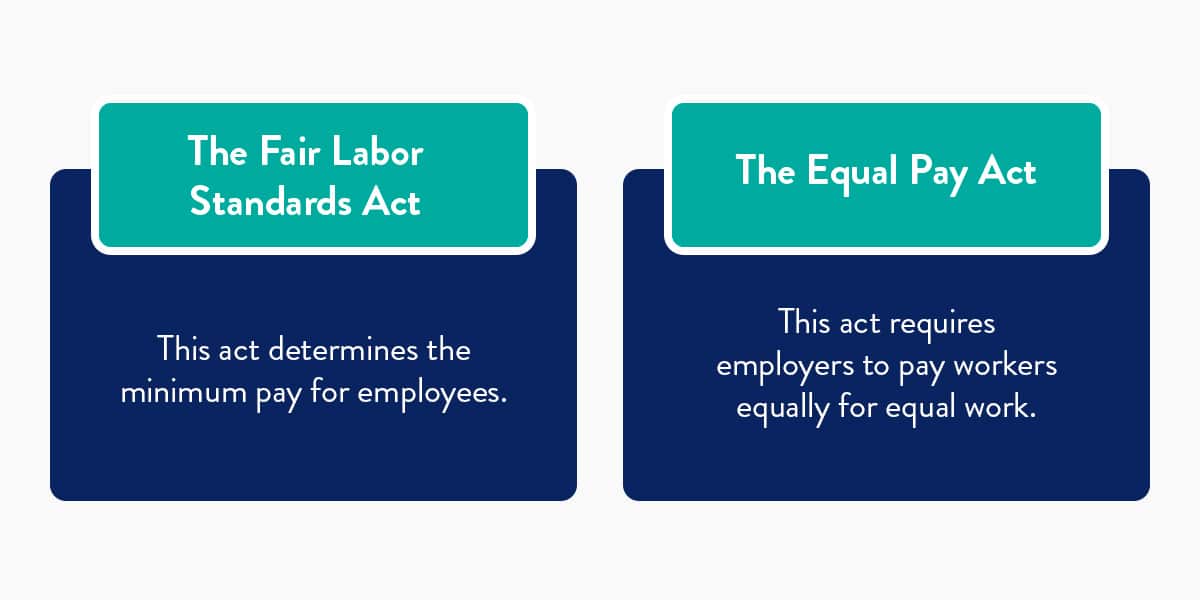Human Capital Management
How to Create a Market-Based Pay Structure

Businesses that want to attract the best talent in their industries need to provide employee salaries that align with others in the market. With a market-based pay structure, backed by market data, your company can be confident it’s offering employees competitive pay.
In This Article:
- What Are Pay Structures?
- What Is a Market-Based Pay Structure?
- Advantages of a Market-Based Pay Structure
- Steps to Create a Market-Based Pay Structure
- Communicating Your Pay Structure With Staff
- How to Monitor and Adapt Your Pay Structure
- Implement a Market-Based Pay Structure for Sustained Success
What Are Pay Structures?
A pay structure consists of pay grades and salary ranges, which companies use to organize their jobs and determine how much to pay their employees. Pay grades are groups of equivalent jobs organized into levels of compensation and importance, or they can be levels of pay for a specific job. A salary range specifies the minimum and maximum amount of pay an employer can pay for employees within a pay grade. Salary ranges allow employers to have some flexibility in adjusting an employee’s salary based on their experience or performance.
Companies use pay structures to:
- Control their spending: A clear, organized pay structure ensures the company knows how much they spend on salaries and makes it easier to budget for new employees.
- Provide fair compensation: Pay structures help companies provide pay equity, where jobs of equal value receive similar compensation.
- Motivate employees: When there is a clear path for progression and an increased salary, employees will feel more motivated and satisfied.
- Decrease raise bias: Companies that set specific pay structures and progression paths can offer raises to employees in a more fair, honest way that is less influenced by bias or personal opinion.
Employers can set each pay level within a pay structure according to internal and external factors. Some of these factors include performance, experience, skill, time at the company and market data.
What Is a Market-Based Pay Structure?
Market-based pay structures involve extensive external market analysis to determine pay grades and salary ranges for jobs. The employer will look at the value of similar jobs in the industry and base the compensation on their findings. The goal is to provide similar — or better — salaries than other companies or competitors. Salary ranges are dependent on the supply and demand of the role in the job market and its geographical location.
Market data is an important part of compensation planning, as it provides a base point for salary ranges. With a market analysis, a company will have a good idea of how they should compensate employees for their experience and skills. While nearly all employers use market data to create a pay structure, the marked-based pay structure is purely focused on matching the market value of a position.
Advantages of a Market-Based Pay Structure

If you choose to implement a market-based pay structure, your company will:
- Remain competitive: Your competitors will want to hire the same people you do. If you want to be the best choice, you’ll need to provide a better compensation package than them.
- Hear from more applicants: When you offer a higher, competitive salary, more people will apply for the position. A larger applicant pool will increase your chances of finding the perfect person for the role.
- Attract skilled workers: People with more experience, education and skills will expect a higher salary. By offering a competitive salary at or above the market average, you’ll appeal to these valuable workers. You’ll also have a better chance of a high-quality applicant accepting a job offer if your salary offer is in line with their industry expectations.
- Retain employees: Companies that offer competitive employee pay and benefits are more likely to have higher retention rates, as employees are more likely to stay when they’re happy with their salary and know it’s the best in the market.
Steps to Create a Market-Based Pay Structure
A base pay structure outlines the monetary compensation a company will offer an employee for how much they work. Base pay excludes other benefits, such as bonuses, health insurance and retirement benefits. Follow the steps below to create an organized base pay structure according to current market data.
1. Determine Your Pay Philosophy
Before you dive into market research, it’s crucial that your company first decides how it wants to approach employee pay. Your approach may be to:
- Match the current market average for salaries.
- Pay slightly less than the market average.
- Offer a higher salary than others in the market.
Your company should choose a compensation philosophy based on numerous factors, such as the company’s overall business objectives, size, location, financial goals, competitors and the current state of the market. For example, if the company is new and has a smaller budget, you may choose to pay less than the market average and make up for it with attractive benefits and perks. If the industry is extremely competitive and there are fewer high-quality candidates, your company could pay higher than the market average.
No matter your approach, ensure the philosophy is fair to employees and you have a solid, well-thought-out reason for your choice. You’ll need to apply this philosophy consistently across multiple areas of the pay structure, and it helps to work with a philosophy you’re confident in.
Your philosophy should also include how often you’ll revisit the company’s pay structure. Company and market situations change, so you’ll need to update your philosophy accordingly so that it can continue to help the company achieve its goals.
2. Outline Job Roles and Responsibilities
In order to create a unique and detailed pay structure, you need to know everything about the jobs within the company.
New businesses should sit with company executives and outline the different jobs the company needs to operate. It’s helpful to organize these jobs into their level of importance within the company’s processes. Next, break up each job into its various elements, including its title, purpose, specific tasks, necessary tools, relationship to the overall company job structure, and knowledge and skills a person needs to perform the job successfully.
Existing companies can conduct a job analysis — internal research to determine the roles and responsibilities each employee performs. Compile this information into detailed job descriptions for each role. To help remove bias from descriptions, focus this analysis on the job itself and not the people who perform it.
3. Collect Market Data

Market data is the most crucial part of developing a market-based pay structure, as it informs the salary ranges for every job. Look for sources relevant to your company’s industry and the area in which your company operates. To ensure data is accurate, consider the main indicators of survey quality, including the source, cost and number of participants. Usually, paid sources are more accurate than free sources, and surveys with a larger pool of participants are more reliable.
A few places you can find salary market data are:
- Government sources: Governments may publish data from salary surveys online. For example, you can access salary data according to area and occupation from the United States Bureau of Labor Statistics.
- Professional HR or trade organizations: Multiple organizations conduct salary surveys and provide their findings as paid packages companies can purchase.
- Free online sources: Online salary websites often provide free information regarding market averages for job positions. While you won’t always find the most reliable data from these websites, it’s a good idea to include it in your research, as potential applicants may see and base their salary expectations on these figures.
- Custom surveys: If some of your job roles are unique and you’re struggling to find market data for them, your company can perform its own surveys. You could also outsource this work to an independent third party to ensure compliance.
4. Find Benchmark Jobs
Before you can use market data to develop pay grades and salary ranges, you’ll need to find similar jobs in the market to compare with yours. This process is called salary benchmarking. Using your detailed list of job descriptions, you can look through the data and find benchmark jobs — jobs common across a variety of industries — that match yours.
Job roles vary, even among the same job titles, so make sure you’re looking at the job’s tasks and responsibilities. Typically, you should aim to match about 70% of the job’s roles and responsibilities with benchmark jobs. The more similar they are, the more accurate your salary ranges will be.
Collect data from multiple surveys for each job so that you have more data. You may need to adjust the data slightly depending on how well the job descriptions match. Other factors like the size of the source company and geographical location may warrant adjustments, too.
5. Establish Pay Grades and Ranges
Now that you’ve outlined your company job roles and collected salary data from similar benchmark jobs, you can form your base pay structure. Your company’s base pay structure will consist of pay grades and salary ranges. A market-based approach differs from traditional pay structures as it sets the salary range per job position instead of a group of jobs.
If you’re using a market-based pay structure, you’ll use the data you’ve collected from each benchmark job to inform the salary range for each job within your company. For a job’s salary range, you can either use the minimum and maximum salaries from the data, or create your own range based around the market average. Your pay philosophy should inform how well you match the market average and ranges.
You can break each job up into separate pay grades with smaller salary ranges that fit within the broad salary range for the job. For example, an employee with less experience may fit into a lower pay grade for a job, and you’ll pay them the lower end of the salary range. To form the pay structure, organize each job by the midpoint of its salary range and group jobs of similar compensation in the same grade. These groups will form your pay grades for the company as a whole.
Sometimes, the external value of a job doesn’t match the internal value of a job. In this case, you will need to move the job into a different pay grade so it represents the company value better. However, you risk offering less or more than the market value. Use your pay philosophy to guide these changes.
6. Navigate Employment Law and Compliance

Throughout the process of creating a pay structure, you need to ensure all the salaries and pay grades meet federal and state laws and regulations. These guidelines provide standards and restrictions for how your company can pay its employees.
Two important laws you need to consider when creating salaries are:
- The Fair Labor Standards Act: This act determines the minimum pay for employees.
- The Equal Pay Act: This act requires employers to pay workers equally for equal work.
Communicating Your Pay Structure With Staff
Once you’ve created your pay structure, you’ll need to inform the relevant people within the company about it. Typically, HR managers and executives have full access to the pay structures and salary ranges, as they help create them. You may choose to provide full access to managers or only share their team’s salary ranges.
For employees, you can focus on explaining what their salary and salary range is, how upward mobility works and your pay philosophy. Being open and honest about pay with employees can promote an environment of trust and increase employee satisfaction.
How to Monitor and Adapt Your Pay Structure
Market averages for salaries change frequently due to economic factors like inflation and shifts in market demand. To ensure your company is consistently keeping up with industry standards and offering competitive rates, you’ll need to monitor trends in market data and update salary ranges and pay grades frequently.
It’s also beneficial to assess how well the pay structure works for the company and make changes to improve it. To assess the effectiveness of your company’s pay structure, you can:
- Request feedback from employees and managers.
- Monitor the financial status of the company to ensure salaries fit current budgets.
- Conduct exit surveys to assess why employees choose to leave.
Implement a Market-Based Pay Structure for Sustained Success
At Exude Human Capital, we know how challenging it is to develop and implement a compensation strategy that is right for your business. With over 60 years of experience in HR consulting, our team of experts is ready to help you navigate the complexities of compensation and human resource management. We’ll work with you to analyze the market, create your salary structure, ensure compliance and make changes when needed.
For personalized assistance in developing and implementing market-based pay structures that drive success, contact us today. We’re happy to answer any questions you have or dive deeper into your requirements with a complimentary 30-minute consultation.








